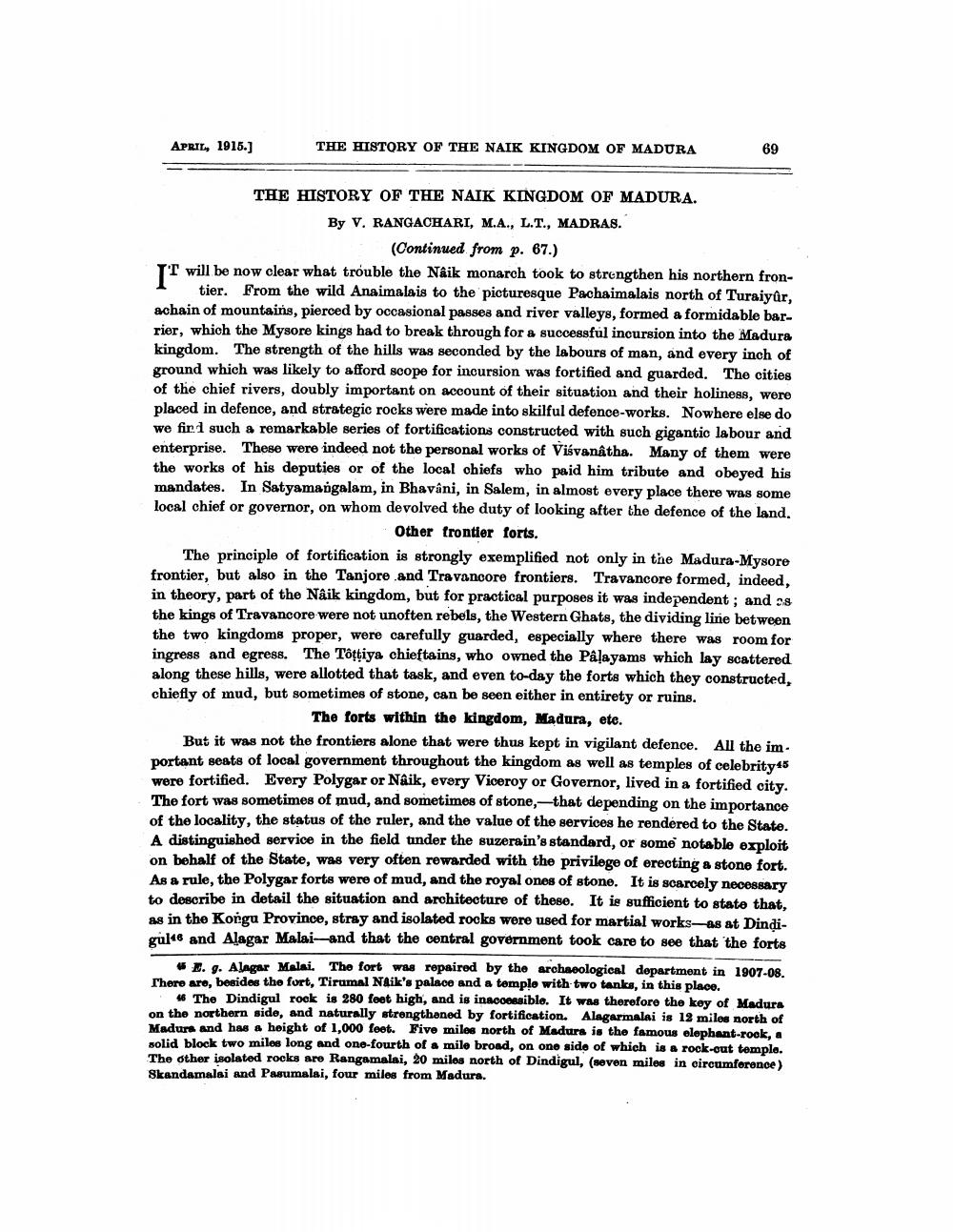________________
APRIL, 1915.)
THE HISTORY OF THE NAIK KINGDOM OF MADURA
69
THE HISTORY OF THE NAIK KINGDOM OF MADURA. By V. RANGACHARI, M.A., L.T., MADRAS.
(Continued from p. 67.) TT will be now clear what trouble the Naik monarch took to strengthen his northern fron
tier. From the wild Anaimalais to the picturesque Pachaimalais north of Turaiyûr, achain of mountains, pierced by occasional passes and river valleys, formed a formidable barrier, which the Mysore kings had to break through for a successful incursion into the Madura kingdom. The strength of the hills was seconded by the labours of man, and every inch of ground which was likely to afford soope for incursion was fortified and guarded. The cities of the chief rivers, doubly important on account of their situation and their holiness, were placed in defence, and strategic rocks were made into skilful defence-works. Nowhere else do we fir such a remarkable series of fortifications constructed with such gigantic labour and enterprise. These were indeed not the personal works of Visvanatha. Many of them were the works of his deputies or of the local chiefs who paid him tributo and obeyed his mandates. In Satyamangalam, in Bhavani, in Salem, in almost every place there was some local chief or governor, on whom devolved the duty of looking after the defence of the land.
Other frontier forts. The principle of fortification is strongly exemplified not only in the Madura-Mysore frontier, but also in the Tanjore and Travancore frontiers. Travancore formed, indeed, in theory, part of the Naik kingdom, but for practical purposes it was independent; and os the kings of Travancore were not unoften rebels, the Western Ghats, the dividing line between the two kingdoms proper, were carefully guarded, especially where there was room for ingress and egress. The Tóttiya chieftains, who owned the Palayams which lay scattered along these hills, were allotted that task, and even to-day the forts which they constructed, chiefly of mud, but sometimes of stone, can be seen either in entirety or ruins.
The forts within the kingdom, Madura, ete. But it was not the frontiers alone that were thus kept in vigilant defence. All the im portant seats of local government throughout the kingdom as well as temples of celebrity 15 were fortified. Every Polygar or Naik, every Viceroy or Governor, lived in a fortified city. The fort was sometimes of mud, and sometimes of stone,-that depending on the importance of the locality, the status of the ruler, and the value of the services he rendered to the State. A distinguished service in the field tunder the suzerain's standard, or some notable exploit on behalf of the State, was very often rewarded with the privilege of erecting & stone fort. As a rule, the Polygar forts were of mud, and the royal ones of stone. It is scarcely necessary to describe in detail the situation and architecture of these. It is sufficient to state that, as in the Korgu Province, stray and isolated rocks were used for martial works as at Dindigul46 and Alagar Malai-and that the central government took care to see that the forts
. g. Alagar Malai. The fort was repaired by the archaeological department in 1907-08. There are, besides the fort, Tirumal NAik's palace and a templo with two tanks, in this place.
4 The Dindigul rook is 280 foot high, and is inaccessible. It was therefore the key of Madura on the northern side, and naturally strengthened by fortification. Alagarmalai is 12 miles north of Madurs and has a height of 1,000 feet. Five miles north of Madurs is the famous elephant-rook, a solid block two miles long and one-fourth of a mile broad, on one side of which is a rock-cut templo. The other isolated rocks are Rangamalai, 20 miles north of Dindigul, (seven miles in circumference) Skandamalsi and Pasumalsi, four miles from Madura.




